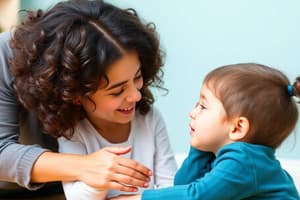Podcast
Questions and Answers
What does cultural transmission primarily facilitate?
What does cultural transmission primarily facilitate?
- Subconscious language acquisition
- The development of non-verbal communication skills
- Genetic inheritance of language
- Direct instruction of cultural norms (correct)
How is language acquisition different from language learning?
How is language acquisition different from language learning?
- Both processes yield identical understanding of a language
- Acquisition requires formal education more than learning does
- Learning is an intuitive process while acquisition is conscious
- Acquisition is less focused on structure than learning (correct)
Which statement correctly describes overextension in language development?
Which statement correctly describes overextension in language development?
- It refers to a child's use of several words for a single object.
- It occurs when a child learns multiple languages simultaneously.
- It happens when a child uses a unique word for a specific object only.
- It manifests when a child uses one word to refer to multiple items. (correct)
What is a characteristic of a child's language acquisition process?
What is a characteristic of a child's language acquisition process?
Which scenario illustrates a child's overextension accurately?
Which scenario illustrates a child's overextension accurately?
What characterizes caregiver speech?
What characterizes caregiver speech?
At what age does babbling typically begin in children's language acquisition?
At what age does babbling typically begin in children's language acquisition?
What is the primary mode of communication during the holophrastic stage?
What is the primary mode of communication during the holophrastic stage?
Which of the following best describes telegraphic speech?
Which of the following best describes telegraphic speech?
What are the essential requirements for language acquisition in early childhood?
What are the essential requirements for language acquisition in early childhood?
In which stage do children typically string together two words to form basic sentences?
In which stage do children typically string together two words to form basic sentences?
What does it mean to refer to a child as an 'active experimenter' in language acquisition?
What does it mean to refer to a child as an 'active experimenter' in language acquisition?
Cooing typically begins at what age, and what sounds are primarily produced?
Cooing typically begins at what age, and what sounds are primarily produced?
Flashcards
Cultural Transmission
Cultural Transmission
The process of passing cultural elements, like beliefs, values, and behaviours, from one generation to the next.
Language Acquisition
Language Acquisition
Learning a language naturally and intuitively, like a child learning their first language.
Language Learning
Language Learning
Consciously learning the rules and structure of a language, often through formal education.
Overextension
Overextension
Signup and view all the flashcards
Language-Using Environment
Language-Using Environment
Signup and view all the flashcards
Caregiver speech
Caregiver speech
Signup and view all the flashcards
Active experimenter
Active experimenter
Signup and view all the flashcards
Two-word stage
Two-word stage
Signup and view all the flashcards
Holophrastic stage
Holophrastic stage
Signup and view all the flashcards
Telegraphic speech
Telegraphic speech
Signup and view all the flashcards
Cooing
Cooing
Signup and view all the flashcards
Babbling
Babbling
Signup and view all the flashcards
Study Notes
Language Acquisition
-
Children are active language learners, experimenting with language and developing their understanding.
-
Caregiver speech is a simplified style of communication used by adults and older children when speaking to younger children. Characterized by short sentences, simplified grammar, obvious questions to which the caregiver knows the answers, restricted vocabulary, slow speech and many repetitions.
-
Stages of Language Acquisition:
- Cooing (4 months): Single vowel sounds like "ooh" and "aah."
- Babbling (6-10 months): Consonant-vowel or vowel-consonant sounds like "ma," "da," "um."
- Holophrastic Stage (12-18 months): Single words used to express needs or communicate, such as "juice" meaning "I want juice."
- Two-Word Stage (18-20 months): Two-word sentences are formed to communicate basic concepts. For example: "mommy up" or "more juice."
- Telegraphic Speech (2-2.5 years): Simple sentences with grammatical variations and correct word order. An example is: "This shoe wet."
-
Basic requirements for language acquisition during a child's first two or three years of development: interaction with other language users, exposure to a particular language and physical capability to send and receive sound signals. A child needing no exposure to language will learn no language.
-
Cultural transmission is essential for language acquisition. It's a process where cultural elements (attitudes, values, beliefs, and behaviors) are shared and taught to individuals and groups. The specifics of a child's language is learned, not genetically inherited.
-
Acquiring a language is an intuitive, subconscious process, while learning a language is a conscious process of understanding the structure, making it possible to comprehend more complex communication.
-
Overextension is a common phenomenon in a child's early vocabulary development. This means a child uses a single word to refer to multiple objects or concepts rather than using different words for different things. For example, a child may use the word "dog" to refer to all four-legged animals, or "apple" to refer to any round object.
Studying That Suits You
Use AI to generate personalized quizzes and flashcards to suit your learning preferences.




